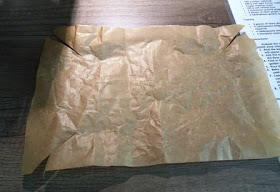My brother, who lives 60 miles away, has been in more or less solitary confinement for six weeks and has barely ventured out except to buy food, most of which he gets from his small local Co-op.
One of the things he struggled to get was bread. No problem, he thought, as he has a breadmaking machine. Then he discovered, like the rest of us, that there was no flour to be had in the shops, even extending his search to larger supermarkets.
Anyway, I have been lucky.
In our local Tesco and Aldi I managed to get some self raising flour - Homepride in Tesco and own brand in Aldi. I didn't have high expectations of the Aldi flour but in fact it was perfectly ok.
We also have in our area a small chain of shops called Taylor's who are actually corn merchants. They look like pet shops as they sell pet food and accessories, but they also sell excellent flour. Apparently the local flour hoarders haven't realised that you can buy flour in a pet shop so there is usually some available.
I parcelled up a supply of bread flour to send to my brother so that he could make himself some bread. Also some dried yeast, granulated sugar and a few other bits and pieces that the panic buying locusts had cleared from his local shops, including soap. I also included a loaf tin (in case he preferred to just make the dough in the machine and bake the bread in the oven and apologising for the colour - pink), the box of Homepride SR flour and a jar of ground ginger so that he could make a cake.
I thought about what recipe he could use with what he was likely to have in stock, adapted
this recipe for sticky ginger cake from the Clandestine Cake website, and decided it might be best to try it out myself first. I substituted granulated sugar for the brown sugar, more ground ginger for the preserved ginger, used Stork instead of butter because it creams so easily by hand and drizzled it with golden syrup as I didn't think he would have icing sugar in stock. Because it was baked in a loaf tin, not a round tin, it took 15 minutes longer to bake.
I explained how to line the tin with baking paper, although a bigger piece than this would have been better.
It turned out to be a very nice cake.
It would of course have had a different flavour using the brown sugar and preserved ginger in the recipe, but it was lovely. It was nice and gingery with a soft, even crumb and would also be excellent as a pudding with some custard. Most people could make it from what they have in the kitchen cupboard.
Ingredients
180g Stork margarine (or any spreadable butter, or really soft butter)
180g granulated sugar
3 eggs, beaten together in a small bowl
180g self raising flour
5 tsp ground ginger
2 tblsp golden syrup
1 tblsp golden syrup for drizzling
Method
Grease a 900g (2lb) loaf tin. Cut an oblong of baking paper and use it to line the tin. Slashing the corners will make it easier to fit neatly into the tin. Preheat the oven to 180C / 160 fan / gas mk 4.
Put the margarine into a large bowl with the sugar and beat like hell with a wooden spoon until smooth and creamy.
Add the eggs in thirds, beating in well. Add a spoonful of flour if the mixture seems to curdle.
Add the flour, ginger and golden syrup and stir in gently. (Don't beat.)
Spoon the mixture into the prepared tin and level the top. Bake for 45-50 minutes until golden brown and done.
Remove from the oven and poke holes in the top of the cake with a skewer or knife point. Drizzle some more golden syrup over the cake, probably about a tablespoonful, and spread over the cake with the back of a spoon.
Cool in the tin for 10 minutes. Use the edges of the baking paper to carefully lift the cake out onto a wire rack.
Remember it will be fragile while still warm so, if it doesn't lift out easily, place a plate on top of the cake tin and invert it so that the cake drops out of the tin. Then lift off the tin and place the wire rack on top of the bottom of the cake and tip it upside down again so that the cake ends up the right way up on the rack.
Cuts into 10-12 slices.



















